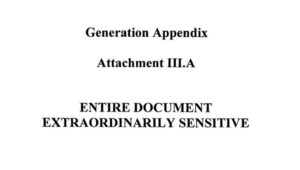
The cover page that declares we the ratepayers cannot see how Dominion Energy Virginia has calculated the levelized cost of energy for its $10 billion offshore wind project. The SCC should break this seal and open this document.
by Steve Haner
When an applicant at the State Corporation Commission claims certain information is proprietary, or extraordinarily sensitive, a reader not privy to the full document can at least get an idea what is missing.
What is missing from the application Dominion Energy Virginia recently filed at the SCC, a document so dense and complex it was broken into eleven volumes, with 61 separate documents (here)? (That is not counting the tables of contents.) Here are some of the topics masked from view that turned up in a cursory review (in the order they appear in the documents):
- The cost of foreign currency hedges the utility proposes to buy (with ratepayer money), because about $4 billion of its planned capital and service purchases will actually be in Euros or Danish Krone and subject to exchange rate risk.
- Information on how it calculated its claimed 97% “availability factor” for the turbines. That predicts how often turbines will be down for maintenance or some other issue over the predicted 30 years of useful life.
- An entire appendix to the generation portion of the application, “which contains the Company’s analysis of the levelized cost of energy.” That is the key financial consideration. Under the Virginia Clean Economy Act, a LCOE determination which is too high would give the SCC the ability to reject the application. (Expect another post on this issue.)
- Seven additional generation appendices dealing with the requests for proposals from various vendors around the world. The bidders, of course, always want their information held confidential, but the SCC might have the authority to release it for public inspection.
- The actual contracts that arose out of the competitive bidding process.
- Projected construction costs by category and year. The annual totals are provided, so masking the individual elements of those totals seems ridiculous. But redacted they are.
- Rows and rows of key financial information related to the long-term operating costs, tax credits, and other key projections used by the company in calculating its annual revenue requirement for the project. The number of black lines blocking data on those pages is jarring. (But enough is available that a future post on this specific topic is called for.)
Dominion has applied for secrecy for all that information, and perhaps more that wasn’t spotted. In a previous post, Attorney General Mark Herring was encouraged to oppose that request once he officially enters the case. Other participants will have the ability to challenge it, as well, once the SCC sets a case schedule and participants start signing up. The first thing they will have to do is sign a non-disclosure agreement to get access to the sealed information.
The bulk of the case paperwork deals with the transmission routes across the 27 miles of sea to the Virginia Beach shore, and then across parts of that city to plug into the existing electrical grid. There are pages and pages of engineering data and maps, plus the required environmental, historical resource and “environmental justice” impact statements.
Those were not reviewed in detail, but in that case no major deletions or redactions jumped out. It is just hard to impossible to see all the maps, charts and photographs in the poorly-scanned versions of the documents. They may appear again in public notices.
That information will be of great interest to the residents and landowners affected, and it would be wise for the regional media to report in detail on those siting issues. It is a major grid rebuild and upgrade, with the portions on land costing $469 million (plus $1.3 billion for the sea connections). Bacon’s Rebellion is not the place for that, but affected people need to be aware and need to dig deeper than the sales pitch the utility will be making.
For the rest of the utility’s 2.6 million customers, it is the cost and reliability of this massive generation investment which will matter and that will be the focus of future discussions. The financial data behind the levelized cost of energy determination is vital and must be released in full. Likewise all the operational costs and the various assumptions used in the company’s own projections on the annual revenue requirement, which runs through 2057.